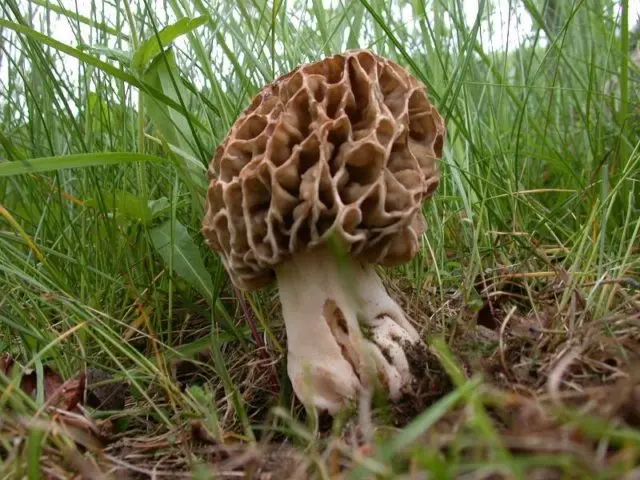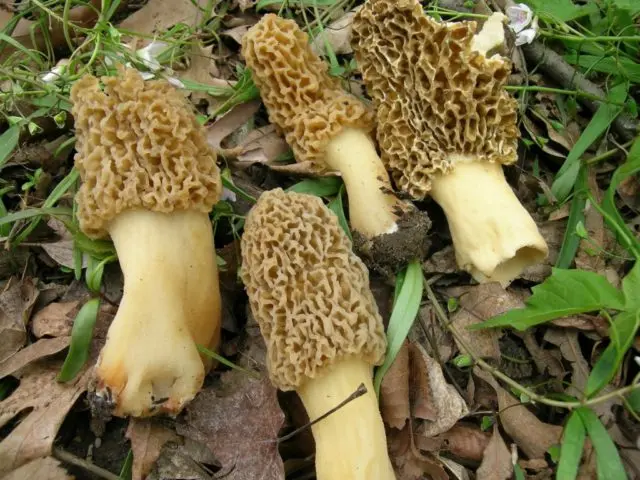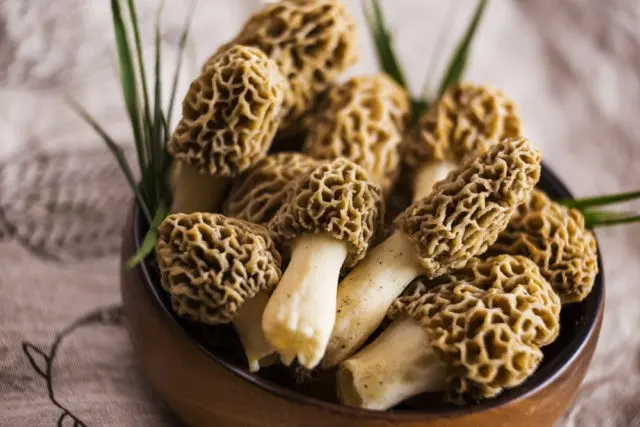Contents
Thick-legged morel (Morchella esculenta) is one of those mushrooms that are listed in the Ukrainian Red Book. Fans of “quiet hunting” will certainly collect the first spring harvest of these delicious mushrooms in order to save it for the winter.
Where do thick-legged morels grow

Thick-legged morels prefer deciduous forests dominated by trees such as ash, poplar, and hornbeam. You can reap a good harvest in areas richly covered with moss. The main condition for the growth of the fungus is fertile soil enriched with organic matter and trace elements.
Most often, thick-legged morels are located in groups – about three fruiting bodies in one bunch. But there are also single copies.
As for territorial preferences, the morel has a fairly extensive geographical coverage: the territory of North America, western and central Europe.
What do thick-legged morels look like
The mushroom got its name due to its appearance: its fruiting body has an impressive size and thickness. To recognize the thick-legged morel is not difficult for a number of signs:
- the cap has a size of 5 to 9 cm, diameter – from 3 to 5 cm, shape – cylindrical-conical or oval, color – yellowish-gray; very deep pits appear on its surface, and the edges can adhere to the stem, especially in mature specimens; the smell and taste of the pulp is pleasant, juicy;
- the height of the entire mushroom is 23 – 24 cm;
- the leg is of a hilly structure, thick, the length can vary from 4 cm to 17, it is about 6 cm in diameter, its color is yellowish-white, there are grooves on the entire surface that are located longitudinally; in structure, it does not have a “fleshy” filling and is hollow and very fragile;
- the seed material consists of spores, which are collected in a kind of cylindrical bags, each of which contains 8 ellipsoid-shaped spores with a smooth surface and a color that varies from light yellow to a more saturated shade; spore powder has a different color, more creamy.

Is it possible to eat thick-legged morel
Thick-legged morel is a conditionally edible mushroom. Therefore, it is important to know that this type of fruit bodies needs high-quality heat treatment, as well as subsequent washing.
The taste of the mushroom morel thick-legged
It is not in vain that connoisseurs of “silent hunting” come forward in search of thick-legged morels every spring. After all, this species belongs to those mushrooms that can be called incredibly tasty. Their fragile but juicy flesh remains so even after roasting and pre-boiling, and the aroma of the mushroom cannot be interrupted even with a lot of spices.
Benefits and harm to the body
In thick-legged morels there are a number of useful substances and trace elements, for which they are valued by lovers of quiet hunting:
- carbohydrates;
- fats;
- proteins;
- disaccharides;
- alimentary fiber;
- monosaccharides;
- ash compounds;
- thiamine;
- riboflavin;
- perfluorooctanoic acid.
In addition, thick-legged morel has a low calorie content – less than 100 kcal per 20 g. Due to this, the mushroom is considered dietary and suitable for people suffering from obesity, diabetes and other metabolic disorders in the body.
Regarding harm, only the fact that this species can be poisoned can be noted. But the risk of such problems exists only with improper preparation of mushrooms. To destroy gelvellic acid (it is hazardous to health and is found in all types of morels), you just need to boil the harvested crop for 15 minutes. and rinse thoroughly under running water. Then the raw materials can be used to prepare various dishes.
False twins of thick-legged morels
It is extremely difficult to confuse the thick-legged morel with some other type of mushroom. The only option is to collect common morels, but they are edible mushrooms, so they do not pose a danger to life and health.

The rest of the varieties have a radically different appearance. This is especially noticeable in the shape of the hat and the size of the legs.
Rules for collecting morels thick-legged
The first harvest can be observed already in April and May. On the territory of Crimea, this type of mushroom grows in March after the 15th. As a rule, thick-legged morels no longer grow in the autumn. But in the context of climate change in recent years in the southern territories of Our Country, a second harvest has been observed, which falls in September.
Despite this, experienced mushroom hunters know that the first harvest is the best. It contains all the necessary vitamins and minerals inherent in this culture.
Regarding the places of the “silent hunting”, it is best to cut the fruiting bodies away from busy places, roads and chemical industries. All these factors are negative, since the fungus is able to accumulate in its pulp harmful substances and heavy salts that are in the ground and air.
The collection of a thick-legged representative is carried out by removing the legs from the soil, and cutting the mushroom is also allowed.
The use of morels thick-legged

Thick-legged morels are conditionally edible mushrooms. Many cooks use them in dried form, adding them to various dishes throughout the winter. If this option is preferable, then it is worth considering the important nuances of preparing dried morels:
- Fruiting bodies must be cleaned of debris and dirt.
- Let dry a little on a flat, dry surface.
- Cut into pieces for convenience (copies can be left whole).
- Dry in any convenient way (oven, open air, microwave, etc.).
- Such mushrooms can be eaten only 40 days after they are completely dried.
In addition to drying, thick-legged morels can be pre-boiled and then used for pickling, pickling, frying, soups and other dishes.
This culture is also used in medicine:
- Hat tincture – used as an external remedy for diseases such as rheumatism, arthrosis, arthritis.
- A decoction of the fruiting body – is used internally for digestive problems.
- From a decoction of hats – eye drops are prepared in the presence of myopia and hyperopia, to strengthen the eye muscles, with cataracts.
Culture has an undoubted benefit on the whole organism as a whole. Therefore, morels are often used by nutritionists in compiling a diet for those who need weight correction and stabilization of the body’s metabolic processes.
Conclusion
Thick-legged morel is a tasty and healthy mushroom that is difficult to confuse with poisonous representatives, so even a novice “silent hunter” can accurately detect it.









